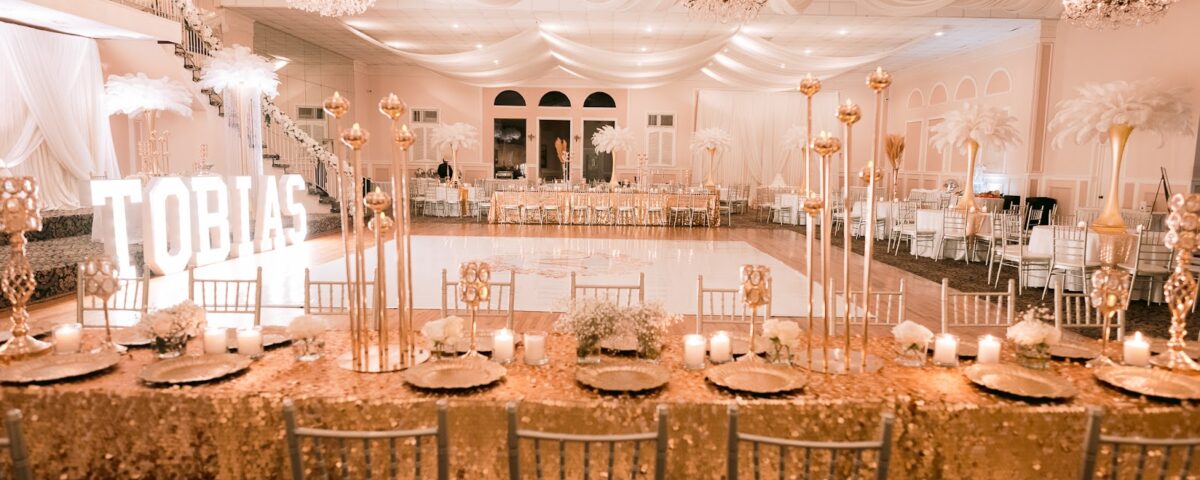
Top Must-Have Dishes for Your Wedding Menu
June 13, 2025One of the most overlooked sources of wedding stress comes not from flowers, music, or even guest lists, but from deciding how to feed everyone. Whether you go with a buffet or seated dinner, the choice carries real consequences for the flow of the evening, your budget, and how your guests experience the celebration.
You might feel torn between the structure and elegance of a plated meal and the flexibility and variety a buffet offers. But the truth is, the buffet or seated dinner decision isn’t just about food, it’s about the type of event you want to create.
Guests will remember the meal, yes, but they’ll also remember how they felt throughout it. Were they relaxed? Were they waiting in line? Were they confused about what came next?
Understanding the pros and cons of each style helps you make a decision rooted in clarity, not pressure.
Buffet or Seated Dinner: Which Fits Your Vision?
Some couples imagine their reception as a formal, graceful affair. Others want a night that feels lively, spontaneous, and full of movement.
The choice between buffet or seated dinner directly impacts the tone of the event.
Buffets invite interaction. People mix and mingle as they move through food stations. Plated dinners, by contrast, offer a sense of calm and rhythm. They invite pause and reflection between speeches and dances.
Ask yourself: Do you want structured elegance or relaxed flow? Both can be beautiful, but not at the same time.
Understanding Your Guest Experience
Comfort vs. Control
With a seated dinner, guests are guided through each part of the meal. They don’t need to make choices or worry about where to go. This can be especially helpful for older guests or those with limited mobility.
A buffet, on the other hand, allows people to choose what and how much they want. It’s often seen as more inclusive, particularly for picky eaters or those with dietary restrictions.
That said, long lines or disorganized stations can quickly turn a buffet from a highlight into a hassle.
Time and flow
One important factor many couples miss is how meal service affects the event timeline.
Plated dinners tend to keep things moving at a predictable pace. Courses arrive on schedule. Speeches are easily slotted between salad and entrée.
Buffets, while more flexible, are harder to control. If there are multiple tables waiting to eat, timing can drift and momentum can lag.
Think of your timeline like a story. The meal is a major chapter, you don’t want it to stall the plot.
Budgeting Realities of Buffet vs. Plated Meals
Don’t assume buffet means cheaper
It’s easy to assume a buffet saves money, but that’s not always true.
Buffets often require more food overall to ensure guests feel they have enough. Caterers must prepare extra portions to avoid running out of popular items.
You may also need more rental equipment, like chafing dishes, serving tables, and sneeze guards, which adds up quickly.
Plated meals allow for precise portions and streamlined kitchen work. While service staff may cost more, the reduced waste and tighter control can balance your budget.
Guest count matters
Smaller weddings may benefit from the warmth and intimacy of a seated dinner. Larger weddings (especially those over 150 guests) might lean toward buffets or even a hybrid approach, such as food stations or family-style service.
The size of your guest list changes the math, not just on cost, but on logistics and guest experience.
Catering Style Based on Wedding Venue
Working with your space
The layout of your wedding venue in NOLA may heavily influence which dining style works best.
Historic ballrooms or elegant courtyards might naturally lend themselves to seated dinners, where movement is limited but atmosphere is key.
Outdoor or rustic venues with more open space may be perfect for buffets or station-style service.
Before you decide, walk through the space and imagine 100+ people lining up, or sitting through a three-course meal. Some spaces handle one far better than the other.
Kitchen access and prep areas
If your venue doesn’t have an on-site kitchen or prep space, that could limit your options. Buffets require food to stay warm and presentable over a longer period, while plated dinners rely on quick, direct delivery.
Talk with your caterer and venue team about what’s realistic for the space.
Creative Alternatives to the Standard Buffet or Seated Dinner
Food stations for variety and movement
Food stations offer a mix of buffet flexibility with more personalized experiences. Guests move between themed setups, like taco bars, pasta stations, or mini seafood boils.
This works especially well in New Orleans, where cuisine is part of the celebration. Imagine a gumbo station, a carving table with roast beef po’boys, or a beignet bar for dessert.
Food stations feel festive but controlled, and often solve the line problem common with standard buffets.
Family-style service
Another option gaining popularity is family-style dining. Guests are seated, but platters are shared across the table.
It encourages conversation and creates a sense of community, while still offering variety and table service.
It’s particularly effective for intimate weddings and creates a cozy, communal feel without the hustle of a buffet.
Thinking Through Guest Comfort and Inclusion
Dietary needs and food variety
Buffets often feel safer for guests with dietary restrictions, as they can see and choose their options. But plated meals allow for pre-planned accommodations, often with more detail and attention.
Ask your caterer about labeling dishes clearly, especially for allergens, gluten-free, vegan, or vegetarian needs.
Good food makes guests feel welcomed. But thoughtful choices around food access and clarity make them feel seen.
Kids, seniors, and accessibility
If your guest list includes children or elderly family members, their needs matter. Buffets can be difficult for those who require assistance or who aren’t comfortable navigating crowds.
In that case, a hybrid may work well, buffet for the majority, with plated service for those who need it. It’s not all-or-nothing.
Final Considerations When Choosing
Formality of your event
If your wedding is black-tie, plated is usually the expectation. It aligns with the overall feel of the evening.
Buffets lean more casual, but that doesn’t mean unrefined. A well-planned buffet can still be polished and upscale.
Match your dining style to the emotional tone of your day.
Your personal priorities
What matters most to you?
If you value guest freedom and variety, a buffet or food station setup might reflect your personality better.
If you’re focused on structure, presentation, and a seamless timeline, a seated dinner may offer more peace of mind.
Neither is right or wrong, it’s about what feels right for you and your partner.
Choose What Supports the Celebration
There’s no universal answer to the buffet or seated dinner debate. But the best decisions are those that align with the kind of celebration you truly want.
You’re not just choosing how food is served. You’re choosing how your guests feel. How they move, talk, eat, and connect.
Start with your vision. Think about your venue, your timeline, and your people. Then build from there, intentionally, thoughtfully, and with care.
Because when the meal flows smoothly, the memories last longer.


